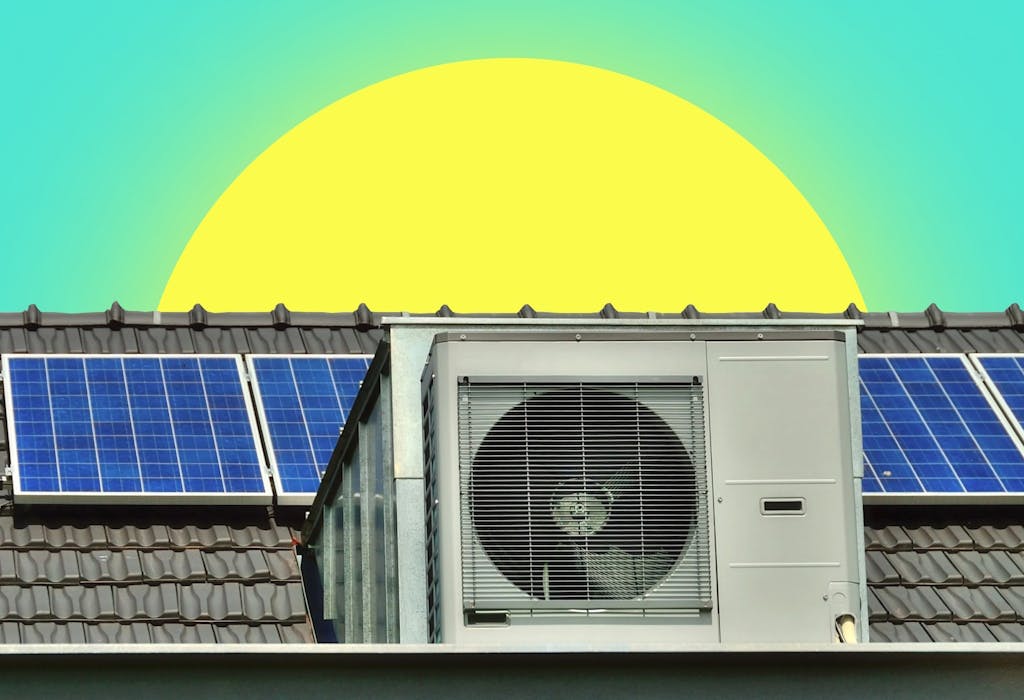- Solar advice hub
- Solar-energy
- UK electricity consumption: is it increasing?
UK electricity consumption: is it increasing?
Here's how the UK's rapid electrification will happen, why it’s necessary, and what it means for households across the country.


Why you can trust our content
We know that the solar industry is full of misinformation, but we only use reliable sources, including:
- Our experienced solar experts, installers and system designers
- Our own database of solar & battery system designs
- Authoritative bodies like MCS and the UK government




At a glance
The success of the UK’s journey to net-zero emissions and greater energy independence will depend largely on its electricity supply.
Over the next decade, the country is set to increase its electricity consumption by 50%, and this spike in demand is going to push up the cost of electricity for everybody.
As the UK phases out coal, gas, and oil, it’ll need a lot of wind, solar, and hydropower to meet this new level of electricity consumption.
In this guide, we’ll explain how this rapid rise will happen, why it’s necessary, and what it’ll mean for households across the UK.
If you’re interested in how much you could save with a solar & battery system, enter a few details below and we’ll generate a quick estimate.
How much electricity does the UK use today?
The UK used 262.9TWh (terawatt-hours) of electricity in 2023, according to government data.
This was 3% less than the country used in 2022, and represented the lowest level of electricity consumption since 1987.
Since the UK hit its all-time electricity consumption peak in 2005, the nation has cut its usage by 26%.
On average, each person now uses 3,889kWh (kilowatt-hours) per year – though that’s not really fair, considering the overall figure includes industrial and commercial usage.
Only 30% of electricity usage is domestic, with households consuming 92.3TWh in 2023 – the least they’ve used since 1989, and 3% less than in 2022.
This fall came as a result of warmer temperatures, higher energy prices, and more energy-efficient devices.
At home, the average person used 1,365kWh of electricity in 2023 – which roughly matches Ofgem’s claim that the typical three-bedroom household consumes 2,700kWh annually.
What’s the long term future of electricity consumption in the UK?
Electricity consumption in the UK is set to increase rapidly over the coming decades, as the country moves towards net-zero carbon emissions - and this is going to drive up the cost of electricity.
In 2021, the UK government passed a law compelling the country to cut its carbon emissions by 78% by 2035, compared to 1990 levels.
As coal, gas, and petrol are phased out, the country’s transport, building, and heating sectors will need to switch to electricity. Heat pumps and electric vehicles will become the norm.
The result will be a 50% increase in demand for electricity by 2035, according to the independent Climate Change Committee (CCC).
UK electricity consumption forecast, 2020-2050
What’s the problem?
This raises three issues. Firstly, the country needs to work out how to source an extra 145TWh of electricity per year by 2035.
Secondly, to ensure that this doesn't interfere with Net Zero plans, the great majority of the UK's electricity must come from renewable sources like solar and wind.
And thirdly, this huge spike in demand is going to drive up the cost of electricity for everybody.
The UK must reduce the carbon intensity of its electricity from 220g of CO2 per kWh in 2019 to 10g per kWh by 2035.
That’s a huge 95% cut in 16 years, though the UK is at least progressing well, having lowered its carbon intensity by 26% from 2019 to 2023, to 162g of CO2 per kWh.
However, the country’s electricity consumption has fallen by 9% in the same period.
It’s easier to cut your emissions when you’re using less electricity; it’s harder when you’re massively ramping up your electricity usage.
The last time the country increased its electricity consumption by 50%, it took 17 years. 2035 is far closer than that, and this time, we must simultaneously decarbonise our electricity.
As demand starts to rapidly rise, it’ll become clear that the scale of this challenge is enormous – and that the only way to achieve it is to rely on solar, wind, and battery storage.
Why will electricity demand increase?
Demand for electricity will increase as the UK increasingly relies on it to power heating and transport systems.
Heat pumps will soon be commonplace in domestic and commercial buildings, powered by electricity that’s already half-green, and will get progressively greener over the years.
In 2020, the government set a target of 600,000 heat pump installations per year by 2028, and with the help of the £7,500 heat pump grant offered by the Boiler Upgrade Scheme, sales have consistently risen every year since then.
The country isn’t on track to hit the 600,000 figure at the moment, but whether or not it does, the direction of travel is clear.
The number of electric vehicles in the UK is growing in a similar fashion.
In 2020, new hybrid and fully electric cars made up 11% of new car sales, according to the Society of Motor Manufacturers and Traders (SMMT). As of May 2024, the current rate is 26%.
There are now more than 1.1 million battery-electric vehicles in the country, a figure which is set to rise to 25 million by 2035, if the UK is to keep its own target.
Households and businesses are turning to electric vehicles in droves, and the government has a legal and ethical motivation to keep fuelling this rise if it dips, with grants and incentives.

Where will all the extra electricity come from?
The extra electricity will primarily come from zero-emissions or low-carbon sources that help the UK to decarbonise its energy consumption.
That means building wind farms, solar farms, and nuclear power plants as quickly and effectively as possible, to fuel this transition.
The slower the country is at constructing these new sources of energy, the more we’ll have to rely on gas plants that will hinder our attempts to reach our net-zero targets.
Wind
The majority of renewable electricity will come from wind, with the CCC setting an annual generation target of 265TWh by 2035.
That’s more than three times as much wind energy as the 82TWh we produced in 2023.
To meet this target, the UK will need to turn on 3GW of new wind capacity each year – a significant increase on the 1.7GW the country added in 2023.
If we manage it, the UK will more than double its current 29.8GW capacity by 2035.
Thankfully, there’s a political consensus around expanding our offshore wind infrastructure, and onshore wind – which is supported by 80% of people – looks likely to take off in the coming years.
Labour has pledged to double onshore wind capacity and quadruple offshore wind capacity by 2030 – a bold objective that would set up the UK to make its 2035 goal with time to spare.
Solar
60TWh of the UK’s electricity supply in 2035 will come from solar panels.
This will require a sixfold increase from 10TWh in 2019 – and having only grown our solar output to 14TWh by 2023, we need to accelerate this process.
We must build 3GW of solar capacity each year to reach this goal, trebling our current capacity, which is 15.9GW as of April 2024.
Household solar will play a large part in this monumental shift, especially as domestic installations have been responsible for 68% of added solar capacity since the start of 2023, according to our analysis of government data.
Solar farms generate massive amounts of electricity, but with tens of millions of households yet to install solar panels on their roofs – and considering this process takes days rather than months – solar homes will be crucial in decarbonising the UK’s electricity.
If you’re wondering how much you could save with a solar & battery system, enter a few details below and we’ll generate a quick estimate.
Nuclear
Nuclear power will play a comparatively small role in raising our electricity production, providing 10GW of capacity by 2035, according to the CCC.
Though the industry has reached this level before, past and future closures mean that by 2035, the UK will have to add 8GW of new nuclear capacity.
If the 3.2GW Sizewell C site in Suffolk is up and running before 2035, that’ll help a great deal, and the 3.3GW Hinkley Point C plant in Somerset should open by 2031 – but even on top of these, the UK will still need to build another 1.5GW of nuclear capacity to hit the CCC’s target.
This is a big ask, especially since no new nuclear plants have opened in the UK since 1995, and it’s been more than a decade since EDF first proposed the Sizewell site.
Time is running out for nuclear energy to pull its weight – and if it doesn’t, the country will need to step up its solar and wind generation even further.
Gas
Gas will provide 30TWh of the UK’s electricity in 2035 – about 6% of the total supply.
This is a massive drop from 2023, when gas powered 32% of the country’s electricity with 98TWh.
However, this plan relies on the UK’s ability to develop effective carbon capture and storage (CCS) technology that can trap CO2 emissions from fossil fuels like gas, then bury them deep underground.
If this proves too difficult, we may have to move away from gas entirely – which again, means more reliance on wind, solar, and battery storage.
To learn more about the UK's gas consumption, check out our guide to where the UK gets it gas from.
Hydrogen
Another 20GW of electricity could be sourced from hydrogen, with the CCC predicting that some gas plants will switch to hydrogen before 2030.
This seems optimistic though, especially after plans to trial the use of hydrogen for home heating were abandoned in three separate locations between 2023 and 2024.
It’s not been tested properly yet, which means it’s a long way from being viable – and there isn’t much time to make it work and roll it out widely before 2035.
Will the national grid need upgrading?
The national grid will absolutely need upgrading, which is why the company that owns the utility – also called National Grid – has already begun the process.
The Great Grid Upgrade is an enormous £4.5bn project that’s set to create new lines and infrastructure, reinforce networks, and improve lines to enable them to send more electricity across England and Wales.
The initiative will upgrade both the transmission network – which moves electricity around the country – and the distribution network, which transports electricity from the transmission network to cities, towns, and villages in an area.
As well as being enhanced and expanded, the grid will also be decentralised.
This will mean it can quickly supply energy to more areas of the country, and better manage the electricity produced by an increasing number of solar homes.
All of these improvements should also enable the grid to serve a customer base that may move its peak usage periods as new tariffs, technologies, and working patterns rise in popularity.
All of this work will create as many as 400,000 low-carbon jobs over the next three decades, according to the CCC.
Where will all the extra electricity be stored?
It’ll be crucial to build up our storage capacity to hold all this extra electricity for as long as possible.
The two biggest contributors to the UK’s electrification revolution will be wind and solar, which both produce variable levels of energy throughout the year, unlike fossil fuels.
Solar panels only create electricity during daylight hours – and their generation rates fall sharply in winter – while wind turbines are usually less productive during the day and summer.
This means they often dovetail perfectly, but not always – sometimes one of these sources will dip at the wrong time, and every so often both will drop, resulting in dunkelflaute. This German term refers to periods of time when the wind doesn’t blow and the sun doesn’t shine.
The public needs to be able to use electricity at any time of day, all year round – meaning we must build enough storage around the country to see us through dunkelflaute periods.
That will mean hitting 18GW of battery storage capacity by 2035, which is a large increase on the 1.6GW we had in 2022.
Thankfully, the UK’s battery storage capacity is growing rapidly. We’ve already reached 6GW, with additional sites that have a combined capacity of more than 30GW having received permission to start building.
Industrial storage
The main form of electricity storage will be industrial, in the form of battery storage and pumped storage hydropower sites.
Battery facilities are usually located near grid substations and can take up anywhere from one to 50 acres, and consist of large, long storage boxes that look like shipping containers.
Inside these containers sit electric batteries that can move electricity to and from the grid, as needed.
When renewable systems produce an abundance of electricity, these sites can draw power from the grid and store it – and when generation drops, they can send this electricity back to the grid to help make up the difference.
Extra electricity will also be held in pumped storage hydropower sites, which make up the vast majority of global battery infrastructure.
These plants use electricity to pump water into an upper reservoir, then during high-demand times, they release this water through a turbine and into a lower reservoir.
The turbine produces electricity for the grid, and the water that’s gathered in the lower reservoir will be pumped into the upper reservoir when wind or solar generation is particularly fruitful.
The electricity is stored in the form of water’s gravitational potential energy – that is, its potential ability to make a turbine spin when it’s sent over a precipice.
The UK currently has 2.8GW of pumped storage hydropower across four plants, but multiple energy companies including Glen Earrach Energy and Drax have announced plans costing billions that may well double or even treble that number over the coming years.
Residential storage batteries
The country will need homes to help provide extra battery storage, as shown by tariffs like Intelligent Octopus Flux.
This time of use tariff financially rewards customers who allow Octopus to store electricity in their battery during low-demand times, then draw it to the grid during high-demand periods.
It effectively enables the supplier to pay households to act as additional battery storage sites.
It’s crucial that companies keep offering incentives like this, as residential batteries are key in ensuring electricity can be held in reserve all over the country, including places where there isn’t much industrial storage.
The size and breadth of this network will need to be continually expanded to achieve the UK’s legally mandated net-zero targets.
Electric vehicles
An electric vehicle battery has an average usable capacity of 72.2kWh, which is 14 times bigger than a standard 5kWh home battery.
And now with the introduction of vehicle-to-grid (V2G) technology, electric cars all over the country will be able to act as massive household batteries.
This process uses a bidirectional charger that can send electricity from your car to the grid, as well as the other way.
It means you’ll be able to charge your car when there’s not much demand on the grid – and prices are lower – then export electricity to the grid during expensive, high-demand periods.
Octopus launched the country’s first V2G tariff, Octopus Power Pack, in 2024. It only works with one charger – but this is just the beginning. Soon it’ll be common across the UK.
We need to balance grid demand
The country must change its electricity usage patterns, to lower the peaks and shift more consumption to times when renewable sources are flourishing.
Time of use tariffs will be a key way of incentivising anyone with a smart meter to adjust their usage. It’ll pay to use appliances like your dishwasher and washing machine during the night, or alternatively, when the sun is shining or the wind is howling.
A growing number of companies will target these tariffs at households with solar & battery systems, electric cars, and heat pumps, because these homes can store electricity and alter their usage patterns.
For the right price, an EV or heat pump owner will shift much of their car charging or home heating to periods of low demand, and someone with a solar & battery system will sell electricity to the grid during high-demand phases.
If we get this right, the country won’t need to generate as much electricity at high-usage times.
With consumption peaks that aren’t as high, we can decarbonise our electricity supply more quickly, as we won’t need to increase our generation capacity to the same extent or build as much battery storage.
Put it this way: a dam needs to be taller than the highest point the water can reach. If you can reduce the water’s peak height, the dam doesn’t have to be as tall.
In the same way, if the UK can reduce its peak electricity usage, its electricity generation and storage infrastructure won’t have to expand as quickly.
Summary
The UK’s electricity consumption is going to sky-rocket and drive up costs, with renewable sources fuelling a green revolution that will make us much less dependent on importing energy from other countries.
It’s already happening. Wind was the UK’s biggest provider of electricity during the first four months of 2024, overtaking gas for the first time – and we’re not going back.
The journey may be bumpy, though, and demand for electricity is already set to stretch the country’s grid and generation capacities, resulting in higher prices for the rest of the decade, at least.
The best way to avoid these potholes and take advantage of all the time of use tariffs coming your way is to get a solar & battery system.
That way, you can generate your own electricity, sell it back to the grid when it’s most profitable, and lessen the blow of any energy price rises.
Related articles

Are solar batteries worth it?
Read full story
Heat pumps & solar panels: the expert guide
Read full story
How to charge your electric car with solar panels
Read full story
Selling electricity back to the grid: the expert guide
Read full story
Written byJosh Jackman
Josh has written about the rapid rise of home solar for the past six years. His data-driven work has been featured in United Nations and World Health Organisation documents, as well as publications including The Eco Experts, Financial Times, The Independent, The Telegraph, The Times, and The Sun. Josh has also been interviewed as a renewables expert on BBC One’s Rip-Off Britain, ITV1’s Tonight show, and BBC Radio 4 and 5.